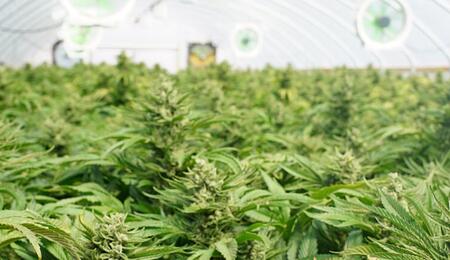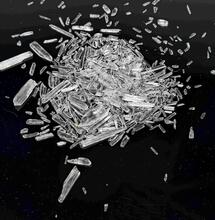Grow Room Hazards

With a little care and common sense, many dangers involved with a grow room can be avoided. What materials and how they are used, as well as the condition of your finished herbs, compose the major risks coming from within a grow room.
With a little care and common sense, many dangers involved with a grow room can be avoided. What materials and how they are used, as well as the condition of your finished herbs, compose the major risks coming from within a grow room.
Growing brings with it great risk and responsibility. Decisions made will have the potential to affect yourself, the community, and the patients and family you are growing for. My father always said, "you will make your own bed, and you will lie in it." With a little care and common sense, many dangers involved with a grow room can be avoided. What materials and how they are used, as well as the condition of your finished herbs, compose the major risks coming from within a grow room.
'Materials' in a grow include all of the equipment, as well as the chemicals you may use in the process. Some grow equipment may only pose a mild risk to a user, or none at all; while others can cause serious injury and, in some cases, death. Electrical equipment failures can easily become deadly. Improper wiring and overloading circuits generate many structural fires across the country. A house fire can spread effortlessly to a neighbor's, and an apartment fire can rapidly burn a whole complex down. Family and neighbors are not alone in this risk. Emergency responders lose their lives every year putting out these fires and rescuing people. Even a small fire is enough to alert authorities. In a medical state this may not be a major problem if you're up to code with license and permits, but for most Americans it would be the beginning of some serious legal issues, and potential jail time. Having a basic understanding of how electricity works in a home will help you make good choices. Using old and frayed equipment is looking for trouble. Electrical outlets and lights are powered by circuits; each circuit is controlled by a breaker, which connects to the main and then out into the grid. A room may be on one or several circuits. You can easily map your room's circuits by having appliances and lights on while you flip the circuit breakers off to see where they lead. This way, if a breaker trips from an overload, you can spread some of the offending equipment onto different circuits - or bring in an entirely new one. People are tempted to put in a larger breaker when their breakers continually trip, but home wiring is not always thick enough to handle the wattage. The wire will heat up until it catches fire. So how many watts can a circuit handle? Well, standard homes are either 15-amp breakers x 120 volts = 1800 watts or 20-amp breakers x 120 volts = 2400 watts. For continuous loads over three hours (which is what every indoor grower is going to need) these numbers are 20% less, so a 15-amp breaker is more like a 12-amp pushing 1440 watts. Exceeding the wattage flips breakers. If your breaker does not flip, melting wires will induce electrical fires. Be smart - do not overload circuits! [caption id="attachment_9243" align="alignnone" width="960"] Replicating the sun indoors requires lighting. Some lights, like metal halides, can be irritating to the eyes and skin. Prolonged exposure causes premature aging and the potential for skin cancer. Eye protection, hats and long-sleeved shirts will minimize this exposure. Even cool white fluorescents can have negative effects. This type of fluorescent light has been shown to increase low-grade stress conditions and depression. Germany has banned these lights in work environments.
Risks from these types of lighting continue well beyond their useful life cycle; for example, mercury is a vital component in the functioning of these lamps. Lights must be recycled to keep mercury from becoming a toxic waste in landfills and leaching out into our waterways. Mercury is an elemental metal and one of only two elements that are liquid at standard room temperature and pressure. Mercury can be included into a group called 'persistent bio-accumulative toxins'. This means it will not break down in the environment, collects in organic tissues, and builds up in the food chain over time. Mercury and most of the compounds produced with it are extremely toxic. Even at low-level exposure it may produce profound nervous system disorders and broad ranging functional disturbances, which ultimately can lead to death. Even the growth medium you decide upon has potential repercussions. Vermiculite is mined as a naturally occurring mineral. It is transported sometimes half a world away to an exfoliation plant, where it is heated and expanded (like an air popper making popcorn). Early on in my farming adventures, vermiculite had asbestos contamination. Asbestos is a natural mineral composed of thin, fibrous crystals. Inhalation causes several types of cancer and other serious illness. Fortunately, now that vermiculite is tested for asbestos, it is much safer to use.
Vermiculite contains crystalline silica and is identified on the Material Safety Data Sheets as a hazard. The inhaled dust creates a disease called silicosis, which is a literal scarring of the lungs. This concern is greater in the processing, where there is massive exposure. At the consumer level exposure is thought to be negligible and not a health hazard. I still recommend wearing a bandana or dust mask, and misting with water to keep the dust down. Perlite, a volcanic glass, is mined and also transformed in the same way as vermiculite, with even more expansion potential. It is heated until it softens and moisture bubbles out, expanding it up to 16 times its original size. There are no significant risks in using perlite. The dust is a nuisance, so mist it down with water as well. Rockwool is made of basalt and chalk. These are melted to a liquid state and spun out like cotton candy. Fortunately, rockwool is less potent then asbestos in scarring and producing tumors. The body is more able to break the fibers down. It is still not a good idea to breathe it in or get it into your eyes, as it can be terribly irritating. Some consider media like rockwool a future landfill problem, as it will sit in landfills indefinitely.
Chemicals are a 'can of worms'. Whichever ones you decide to use, remember: less is more. Nutrients for growing in soil or hydroponic systems contain mainly, nitrogen, phosphorus and potassium. These elements are pretty safe to use, as long as you're not ingesting them. Nutrients can become an environmental nightmare if you dispose of them improperly. Excesses beyond what nature can absorb are polluting many of our waterways and coastal areas, creating 'dead zones'. This process is called 'eutrophication'. The degradation of these habitats serving as nurseries for fish is leading to major declines in commercial and non-commercial fisheries. Supporting the conservation and restoration of small streams, wetlands and estuaries will help reduce future damage. Terrestrial ecosystems can also be negatively impacted by eutrophication. The majority of orchid species in Europe have been decimated by this pollution. Chemical pesticides pose an even greater risk for the individual, community and the environment. Pesticides can affect you immediately with rashes and headaches, or years down the road with cancers. The World Health Organization estimates upwards of 18,000 people die a year from pesticide exposure. Avoid using the super toxic persistent ones that bio-accumulate.
Recent government studies exposed that upwards of 80% of fresh water fish in the US are contaminated by pesticides. Eliminate use the use of pesticides by following vigorous pest management techniques, like preventing infestation before it occurs. Never use these deadly chemicals into the flowering cycle. Covering your medicine in pesticide and smoking it is not a good idea. Not under any condition should any chemicals be stored in food containers unless they have been heavily re-labeled. Chemical free is a much safer way to grow for everyone involved; however, man-made toxins are not the only hazards coming out of a grow room that can harm Cannabis patients. Growing in humid conditions or curing improperly and allowing mold to develop can be an easily-preventable danger. Dehumidifiers, as well as temperature controls, are available on the market. Bugs will also pollute flowers with bacteria and molds. Aspergillus is a common mold we are exposed to on a regular basis. In the body it causes Aspergillosis and takes on several forms. In Aspergilloma, a fungus ball develops on past lung disease or scarring. In pulmonary aspergillosis, an allergic reaction usually develops in someone who already has lung problems, like asthma. The pulmonary type is invasive and will spread throughout the body. A healthy person may be able to fight off this fungus, but patients with compromised immune systems are especially at risk. Several people have died from smoking Aspergillus-contaminated Cannabis.
Threats from without are other dangers prevalent in a grow room. Freud once said, "No mortal can keep a secret. If the lips are silent, he chatters with the fingertips; betrayal oozes out of him at every pore." Just like fight club, the first rule of growing is DO NOT TALK ABOUT IT! The more individuals that are aware, the more chance for the wrong ones to find out. Pulling beautiful, pristine colas out at parties to impress lots of random people is probably not a good idea.
Police informants can earn money, and some are allowed to continue nefarious acts - as long as they feed their handlers new people to bust on a regular basis. Police also reduce charges and sometimes offer to 'make it easy on' someone if they share information. Many busts are because of informants. The zeitgeist growing up was, "We are lucky to be free and not to be in a communist country where you cannot trust your neighbors and friends." It is troublesome how we have become what we abhor.
[caption id="attachment_20387" align="alignnone" width="2121"]
Replicating the sun indoors requires lighting. Some lights, like metal halides, can be irritating to the eyes and skin. Prolonged exposure causes premature aging and the potential for skin cancer. Eye protection, hats and long-sleeved shirts will minimize this exposure. Even cool white fluorescents can have negative effects. This type of fluorescent light has been shown to increase low-grade stress conditions and depression. Germany has banned these lights in work environments.
Risks from these types of lighting continue well beyond their useful life cycle; for example, mercury is a vital component in the functioning of these lamps. Lights must be recycled to keep mercury from becoming a toxic waste in landfills and leaching out into our waterways. Mercury is an elemental metal and one of only two elements that are liquid at standard room temperature and pressure. Mercury can be included into a group called 'persistent bio-accumulative toxins'. This means it will not break down in the environment, collects in organic tissues, and builds up in the food chain over time. Mercury and most of the compounds produced with it are extremely toxic. Even at low-level exposure it may produce profound nervous system disorders and broad ranging functional disturbances, which ultimately can lead to death. Even the growth medium you decide upon has potential repercussions. Vermiculite is mined as a naturally occurring mineral. It is transported sometimes half a world away to an exfoliation plant, where it is heated and expanded (like an air popper making popcorn). Early on in my farming adventures, vermiculite had asbestos contamination. Asbestos is a natural mineral composed of thin, fibrous crystals. Inhalation causes several types of cancer and other serious illness. Fortunately, now that vermiculite is tested for asbestos, it is much safer to use.
Vermiculite contains crystalline silica and is identified on the Material Safety Data Sheets as a hazard. The inhaled dust creates a disease called silicosis, which is a literal scarring of the lungs. This concern is greater in the processing, where there is massive exposure. At the consumer level exposure is thought to be negligible and not a health hazard. I still recommend wearing a bandana or dust mask, and misting with water to keep the dust down. Perlite, a volcanic glass, is mined and also transformed in the same way as vermiculite, with even more expansion potential. It is heated until it softens and moisture bubbles out, expanding it up to 16 times its original size. There are no significant risks in using perlite. The dust is a nuisance, so mist it down with water as well. Rockwool is made of basalt and chalk. These are melted to a liquid state and spun out like cotton candy. Fortunately, rockwool is less potent then asbestos in scarring and producing tumors. The body is more able to break the fibers down. It is still not a good idea to breathe it in or get it into your eyes, as it can be terribly irritating. Some consider media like rockwool a future landfill problem, as it will sit in landfills indefinitely.
Chemicals are a 'can of worms'. Whichever ones you decide to use, remember: less is more. Nutrients for growing in soil or hydroponic systems contain mainly, nitrogen, phosphorus and potassium. These elements are pretty safe to use, as long as you're not ingesting them. Nutrients can become an environmental nightmare if you dispose of them improperly. Excesses beyond what nature can absorb are polluting many of our waterways and coastal areas, creating 'dead zones'. This process is called 'eutrophication'. The degradation of these habitats serving as nurseries for fish is leading to major declines in commercial and non-commercial fisheries. Supporting the conservation and restoration of small streams, wetlands and estuaries will help reduce future damage. Terrestrial ecosystems can also be negatively impacted by eutrophication. The majority of orchid species in Europe have been decimated by this pollution. Chemical pesticides pose an even greater risk for the individual, community and the environment. Pesticides can affect you immediately with rashes and headaches, or years down the road with cancers. The World Health Organization estimates upwards of 18,000 people die a year from pesticide exposure. Avoid using the super toxic persistent ones that bio-accumulate.
Recent government studies exposed that upwards of 80% of fresh water fish in the US are contaminated by pesticides. Eliminate use the use of pesticides by following vigorous pest management techniques, like preventing infestation before it occurs. Never use these deadly chemicals into the flowering cycle. Covering your medicine in pesticide and smoking it is not a good idea. Not under any condition should any chemicals be stored in food containers unless they have been heavily re-labeled. Chemical free is a much safer way to grow for everyone involved; however, man-made toxins are not the only hazards coming out of a grow room that can harm Cannabis patients. Growing in humid conditions or curing improperly and allowing mold to develop can be an easily-preventable danger. Dehumidifiers, as well as temperature controls, are available on the market. Bugs will also pollute flowers with bacteria and molds. Aspergillus is a common mold we are exposed to on a regular basis. In the body it causes Aspergillosis and takes on several forms. In Aspergilloma, a fungus ball develops on past lung disease or scarring. In pulmonary aspergillosis, an allergic reaction usually develops in someone who already has lung problems, like asthma. The pulmonary type is invasive and will spread throughout the body. A healthy person may be able to fight off this fungus, but patients with compromised immune systems are especially at risk. Several people have died from smoking Aspergillus-contaminated Cannabis.
Threats from without are other dangers prevalent in a grow room. Freud once said, "No mortal can keep a secret. If the lips are silent, he chatters with the fingertips; betrayal oozes out of him at every pore." Just like fight club, the first rule of growing is DO NOT TALK ABOUT IT! The more individuals that are aware, the more chance for the wrong ones to find out. Pulling beautiful, pristine colas out at parties to impress lots of random people is probably not a good idea.
Police informants can earn money, and some are allowed to continue nefarious acts - as long as they feed their handlers new people to bust on a regular basis. Police also reduce charges and sometimes offer to 'make it easy on' someone if they share information. Many busts are because of informants. The zeitgeist growing up was, "We are lucky to be free and not to be in a communist country where you cannot trust your neighbors and friends." It is troublesome how we have become what we abhor.
[caption id="attachment_20387" align="alignnone" width="2121"] Controlled by fear and ignorance, the 'dominant culture' forgets that laws based upon science were what propelled us out of the Dark Ages. These laws, created to control and influence economic markets, are for the benefit of the few and erode the principle foundation of our liberty. We find ourselves facing this intractable situation, where a for-profit prison industry and treatment complex actively lobbies to create harsher penalties, to put us in jail and keep us there longer - for an herb statistically safer than caffeine.
Relationships are another great danger for a grow room. Sharing every detail of your life with someone you have only been dating a short while can come back and bite you in the ass if you have a nasty split. Even a multiple-year relationship can become ugly and lead to horrible repercussions. I'm not advocating that you become a celibate monk, just use discretion: over the years I have aided in several grow room evacuations due to a result of insane relations. Love is easier said then done.
'Rippers' (crop thieves) are another increasing risk. Some are organized gangs that earn complete - or at least supplemental - incomes robbing grow operations. There is a group in the Midwest that is notorious for robbing and tying up their victims, then calling the police to bust them for what's left behind.
In the '90s it was figured that Cannabis could be commercially produced outdoors for a penny a pound, like broccoli. The prices for quality indoor can still fetch upwards of $4,000 (US) per pound. Considering these black market conditions, and potential for large sums of cash, it is possible some of these gangs are rogue cops. In fact, small and large sums of money often disappear into police pockets on house raids. Our boys in blue are the largest gang out there, after all.
"Loose lips sink ships," is definitely the motto to live by as you're getting ready to start your future grow room, or if you already have one going. The less people involved, the safer you will be. Staying natural helps to protect your loved ones and the community around you. There are plenty of toxins and environmental degradation happening without you adding to the mix. Making the proper decisions to ensure the safety of everyone involved ought to always be a priority in your mind. And don't forget Rule #1: DO NOT TALK ABOUT IT!
Controlled by fear and ignorance, the 'dominant culture' forgets that laws based upon science were what propelled us out of the Dark Ages. These laws, created to control and influence economic markets, are for the benefit of the few and erode the principle foundation of our liberty. We find ourselves facing this intractable situation, where a for-profit prison industry and treatment complex actively lobbies to create harsher penalties, to put us in jail and keep us there longer - for an herb statistically safer than caffeine.
Relationships are another great danger for a grow room. Sharing every detail of your life with someone you have only been dating a short while can come back and bite you in the ass if you have a nasty split. Even a multiple-year relationship can become ugly and lead to horrible repercussions. I'm not advocating that you become a celibate monk, just use discretion: over the years I have aided in several grow room evacuations due to a result of insane relations. Love is easier said then done.
'Rippers' (crop thieves) are another increasing risk. Some are organized gangs that earn complete - or at least supplemental - incomes robbing grow operations. There is a group in the Midwest that is notorious for robbing and tying up their victims, then calling the police to bust them for what's left behind.
In the '90s it was figured that Cannabis could be commercially produced outdoors for a penny a pound, like broccoli. The prices for quality indoor can still fetch upwards of $4,000 (US) per pound. Considering these black market conditions, and potential for large sums of cash, it is possible some of these gangs are rogue cops. In fact, small and large sums of money often disappear into police pockets on house raids. Our boys in blue are the largest gang out there, after all.
"Loose lips sink ships," is definitely the motto to live by as you're getting ready to start your future grow room, or if you already have one going. The less people involved, the safer you will be. Staying natural helps to protect your loved ones and the community around you. There are plenty of toxins and environmental degradation happening without you adding to the mix. Making the proper decisions to ensure the safety of everyone involved ought to always be a priority in your mind. And don't forget Rule #1: DO NOT TALK ABOUT IT!
S
Soft Secrets



